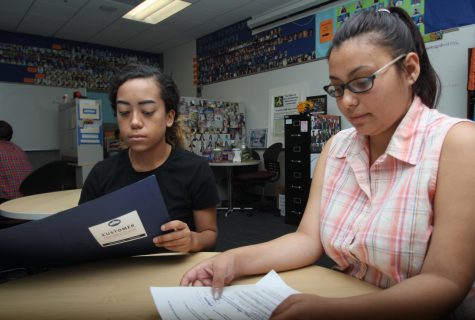AB 540 City College students come back from the White House
October 24, 2016

Kenia Valence-Galeana and Ana Karina Lomeli-Cadenas in the Price Scholarship Program office
This November, two City College students will not be able to vote for a new White House tenant.
Last month, Ana Karina Lomeli-Cadenas and Kenia Valence-Galeana, took a trip to the White House.
“We are AB 540 students,” said Cadenas on Sept. 27, at The Price Scholarship Program office. “AB 540 is for students who are undocumented, which means that they are not U.S. citizens and they are still going to school in a legal sense.”
Cadenas, an Urban Studies major, and Galeana, a Business Management major, both 19 years old, feel the extra pressures that come with an education.
“They tell you that being an AB 540 student that ‘you cannot do it,’” said Galeana. “Then you do see these others that have made successful careers out of being AB 540 students – it is something that is achievable.”
Prior to the passing of recent immigration laws, undocumented immigrants struggled in an uneven playing field in the post K-12 education process.
“AB 540 students don’t apply for financial aid like everybody else does,” Cadenas said. “The Dream Act allows us to pay in-state tuition and apply for the BOG (Board of Governors) Waiver. When we reach the University level, (if approved) we are given a Cal Grant. It’s pretty much like financial aid and it’s about half of our tuition.”
“Applying for the Dream Act is equivalent to applying for FAFSA (Free Application for Federal Student Aid) for the other students,” Galeana said. “And then there is the BOG Waiver that covers the cost of the classes in community college.”
The California Dream Act is defined on the California Student Aid Commission (CSAC) website. It allows undocumented and nonresident documented students who meet certain provisions to apply for and receive private scholarships.
“One of the biggest challenges of being an AB 540 (student) is the fact that we are limited to resources that we are allowed to get when paving our way through school, whether it be financially, through internships, or work permits. A lot of them require for you to be a United States citizen,” Cadenas added.
The Price Scholarship office on the fourth floor of the MS Building is another good resource for AB 540 students.
“As a first generation college student, Price Scholarship has definitely gIven me the support that I needed,” Cadenas said. “One thing that we learned at Price is always to be creators so when I did my thank-you speech at the White House, I said that I was an ‘opportunity piranha.’ So whenever something presents itself, I’m definitely going for it.”
Their website states, “The Price Scholarship Program assists students from San Diego to complete an Associate Degree and/or Certificate Program at San Diego City College in two to three years. The assistance we provide for students comes in many forms: financial assistance, seminars, individual counseling, mentoring, a program retreat, and social events.”
On Sept. 19, Cadenas, Galeana, and their two mentors, Sandra Bauler and Amanda Cheyney, youth program specialists from San Diego Workforce Partnership (SDWP), flew to Washington, DC, to present a proposal that they made based on “customer-centered design thinking.”
Their presentation was made at the Department of Labor (DOL) Frances Perkins Building at the White House.
One major issue that many undocumented immigrants face is traveling outside of their place of residence. Many AB 540 students have said that they fear driving through the U.S. Customs and Border Protection checkpoints (i.e., the San Clemente Station on Interstate Highway 5, the Riverside County Line station on Interstate Highway 15, and the Pine Valley Station on Interstate Highway 8). They also said that flying within the U.S. was not an option until the last few years. “Because of DACA,” said both of them.
DACA is an acronym for Deferred Action for Childhood Arrivals.
DACA is explained on the United States Citizenship and Immigrations (USCIS) website. On June 15, 2012, the Secretary of Homeland Security announced that certain people who came to the United States as children and meet several guidelines may request consideration of deferred action for a period of two years, subject to renewal. They are also eligible for work authorization. Deferred action is a use of prosecutorial discretion to defer removal action against an individual for a certain period of time. Deferred action does not provide lawful status.
“DACA (status) protects us when flying and not worry about getting deported,” Galeana said. “And we can work too.”
Cadenas and Galeana admitted that they have to “work harder than the average student.” But they also said that it is OK because they have watched Dream Act, AB 540, and DACA students before them, “doing well for themselves.”
“I think the most important thing out of everything was when Kenia and I got to stand up and really just talk to them (at the Dept. of Labor) and have a ‘heart to heart’ about how we felt,” Cadenas said, “and the passion that we had for this project and how important it is to involve the youth in everything that they do.”
Since the two have returned, they said that they were offered jobs by a few companies present at the White House that Monday afternoon.
“Overall I feel empowered that I was able to go over there, and now I feel like I can do anything,” Galeana said.











